February 1st, 2025 Bhakunde Beshi, Nepal
One year in Nepal is a crazy thing to conceptualize. The feeling of a year seems much shorter than it used to be. I haven’t figured out yet if it’s a Nepal thing or a getting older thing. So much has happened. The idea that a year has passed shouldn’t be surprising, yet somehow it is. While I don’t have the flow of time totally figured out, what I can do is reflect thoughtfully on how time flows over this country. I can truly say that there is something special about every month with the possible exception of April and May, at least where I live. I regretfully don’t have anything nice to say about those months. It becomes absurdly hot, dry as hell, and so smoggy that you start coughing up black phlegm. No, I am not looking forward to the spring. But I am enjoying the weather now, and excited for the summer and autumn.
Put very simply, the weather here can be put into two categories, time spent expecting rain, and time spent not expecting rain. People start expecting rain around May. Naturally, when people expect rain, they start planting. This last year, the first rain came at the beginning of May, and so we planted our corn in the middle of the month. Immediately after, it hardly rained at all, which gave everyone quite the scare. The whole village was brown, hot and smokey…just dying for water. Finally, in the first week of June, the rain came, and it pretty much kept on coming for the next 4 months. That’s not to say that it was always raining, it wasn’t. But, just about every day, usually, during the night, the rain would come.
The effects were beautifully transformative. The smokey monotone sky was replaced with dramatic, towering clouds, backdropped by a brilliant blue. The sunsets traded a soothing haze of orange for explosions of color. When there was no cloud cover, its as hot as an oven, and cloud cover or no, the monsoon is incredibly humid. However, I only minded a little bit, as the true transformation took place in the land. I could not believe how fast the corn grew. Seemingly one foot every week, until they rose above my head, turning everything green. In the second month of monsoon, the farmers prepared their rice paddies by turning over their fields. Usually, there is a bunch of grass growing in soft dirt, so the farmer (sometimes with the help of their handy PCV) turn the grass upside down and, and squash it with their feet, turning it into a big mud pit. The rice paddy is then filled with water, and the rice is planted in a process I still don’t fully understand, but the effect is that the land becomes even more green. The streams that were once only a trickle become a torrent of water, and there are wonderful smells everywhere. The best part of the rain’s arrival though, is the fruit, first lychees, then mangos. Everyone spends a fortnight gorging themselves with their personal supply from a family tree, and then its business as usual again. I personally can’t wait for lychee season to return.
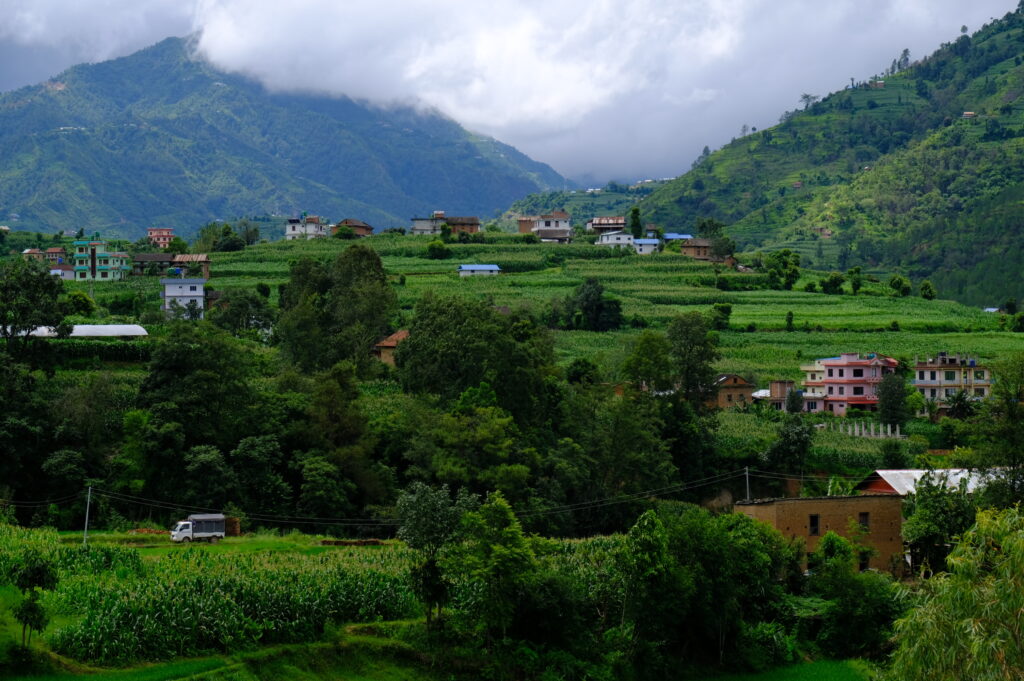
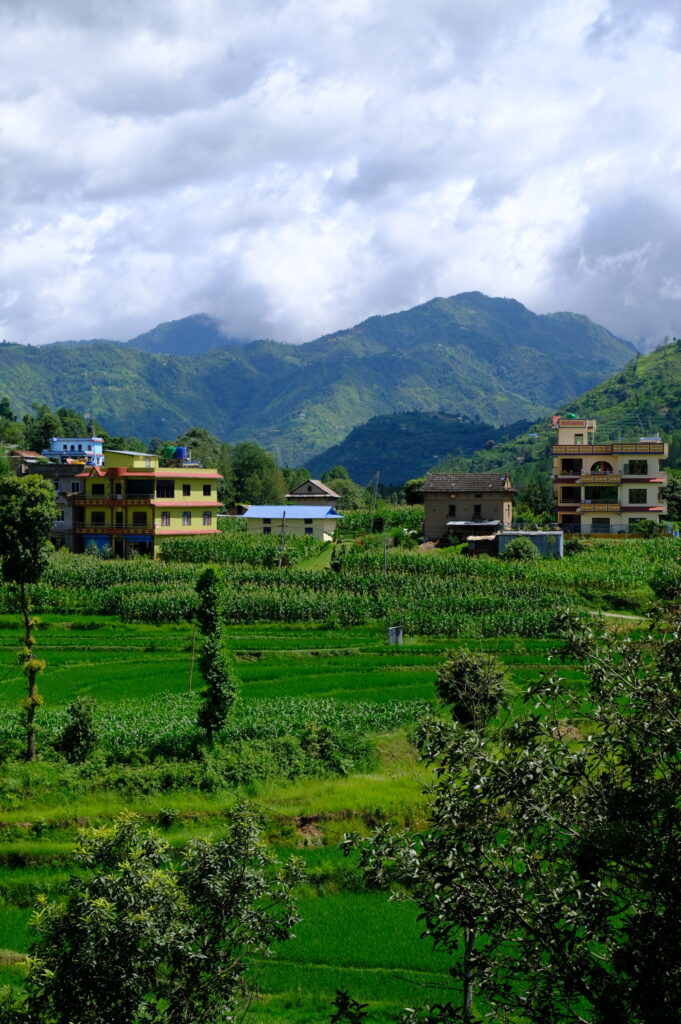
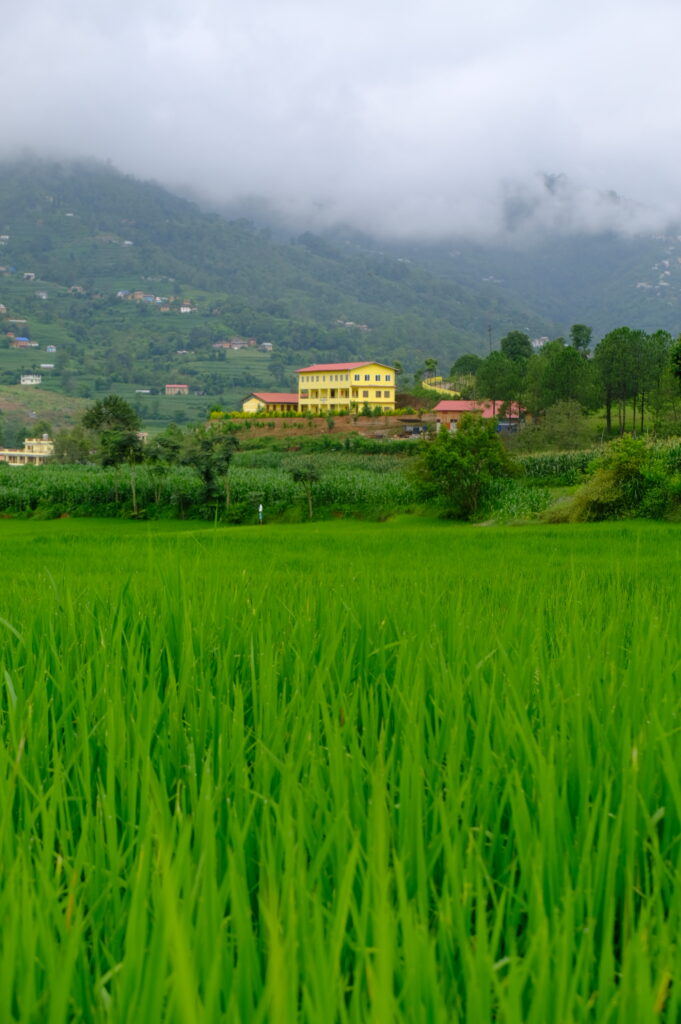
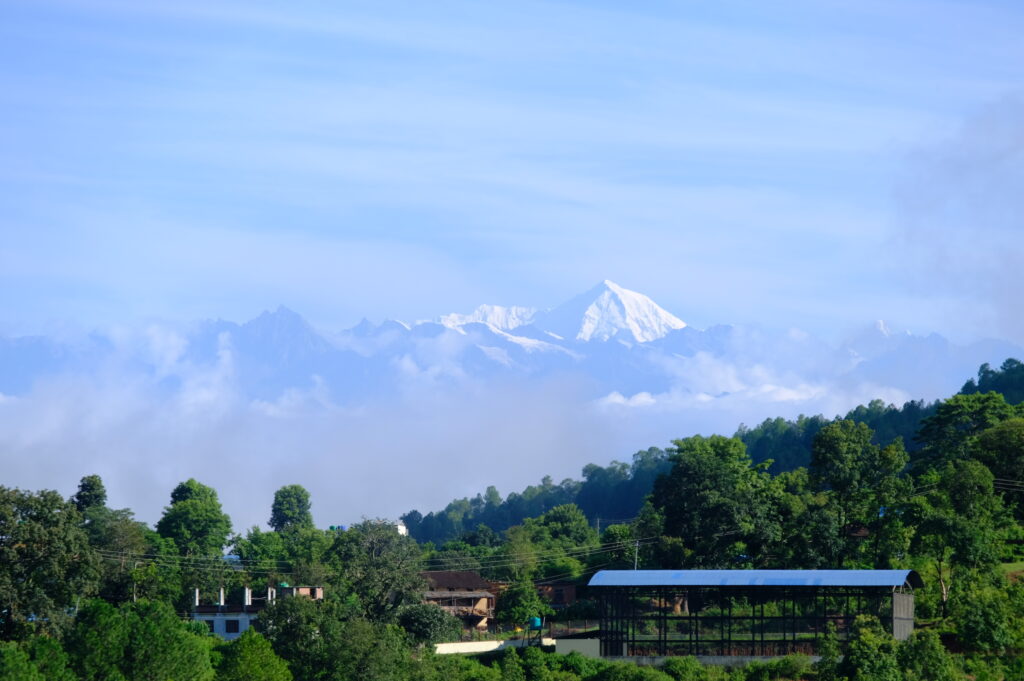
The rain continues until September, when it is supposed to taper off until the celestial tap goes off almost completely. The corn is harvested at this time, and then big festivals begin. Dashai, then Tihar. That was what was supposed to happen, but this year, the tap decided to unexpectantly open all the way back up.
On September 29th, it started to rain two weeks after people were no longer expecting rain, and it didn’t stop raining for 3 days. I’m not talking about a drizzle transitioning back and forth from a steady rain, no. We’re talking about an all-out downpour for the better part of 72 hours. On the night of the third day, the Earth had seemingly absorbed the volume of Lake Michigan, and there was nowhere for the water to go but over the land, and that’s what it did, in astounding volumes. I watched that morning as my road turned into a river, as water exploded out of the rain water trenches, and as dozens of small streams formed where there had only been farmland before.
My bhai (host brother) Prayag rushed up to me early that morning in a state of shock and told me that the temple complex about half a mile downhill was underwater. That’s when the gravity of the weather event set into me. Naturally, I decided that I needed to check it out. I walked down the street through six inches of water rushing past me accompanied by my counterpart teacher Bishnu who had recently moved into the extra room in my house. He was in a state of awe at the weather event. In his entire 37 years, he had never seen rain like this. We would later learn that since they started keeping records in the 1970’s this was the biggest flooding event in the country’s history. As we made our way to the temple complex, we started seeing the aftereffects of the small landslides which were only a microcosm of the devastating impact that landslides had on the region, killing hundreds and destroying thousands of homes, not to mention the impact on critical infrastructure like bridges and roads. When we reached the temple complex, it was momentarily hard to believe what I was seeing.
The temple is built on the confluence of three rivers which is a perfectly normal place for a temple, as the river is used to the wash dead bodies before they are cremated there. On this occasion however, the location of the temple had a devastating impact. The temple is raised about 15 feet above the river bed in anticipation for just such an influx of water. Even so, about 4 feet of water rushed over the entire complex at amazing speeds, carrying away chairs, and speakers while destroying anything not strong enough to withstand the might of the torrent, including the steel bridge that went across the river. The mushroom farms next to the temple were almost unilaterally destroyed, and massive tree branches and boulders were strewn everywhere.
As I saw the water continue to rise around me, I decided to get out of dodge. Down the road, a family whose home was draped with downed powerlines was evacuating their home. Seeing as there was no power, the lines weren’t a threat, but the river carrying away the land next to their house bit by bit was. I helped a frantic group of people empty the house of all possessions and tweaked my back carrying out a massive metal armoire. Luckily, the rain stopped a few hours later, so the house ended up being okay.
The days that followed were surreal. There was no power, and cell coverage from my provider went out for hours at a time and the coverage from the budget provider was out for 4 days. Additionally, the roads both to the East and West of Bhakunde were inaccessible by any motor vehicle as massive landslides blocked the road in some parts, and entire sections of the road had fallen off the side of their mountain in others. In those days, I watched as for the first time since my Dhai’s childhood, helicopters landed in the soccer field to ferry patients in emergency condition to the hospital in Dhulikhel.
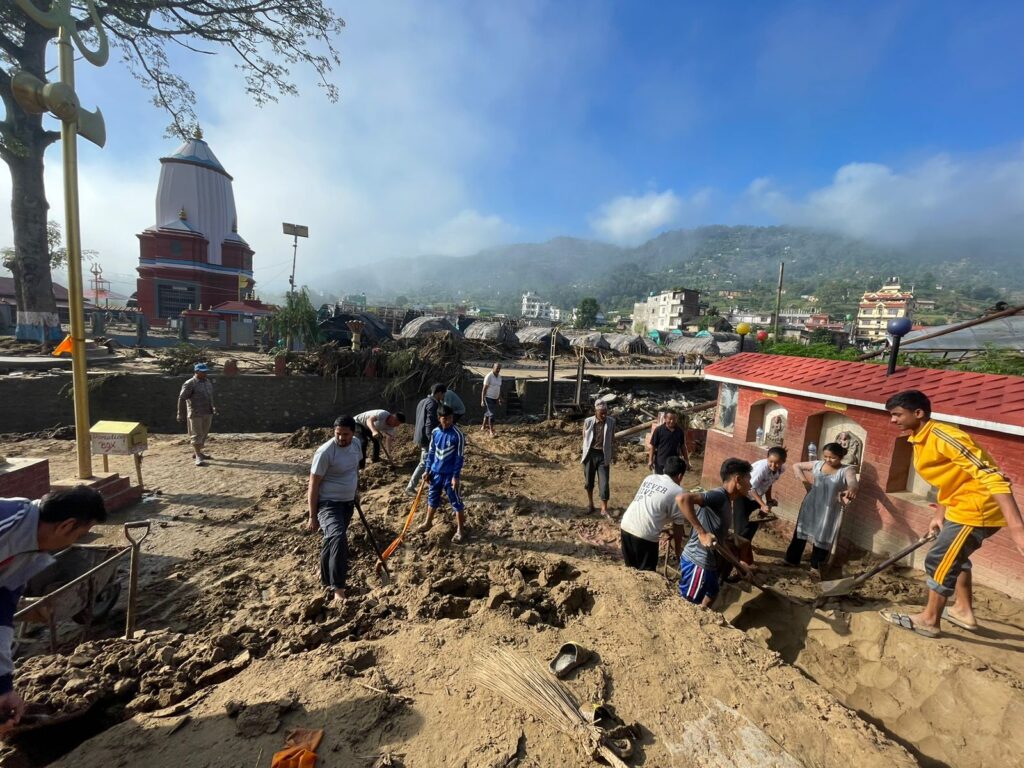
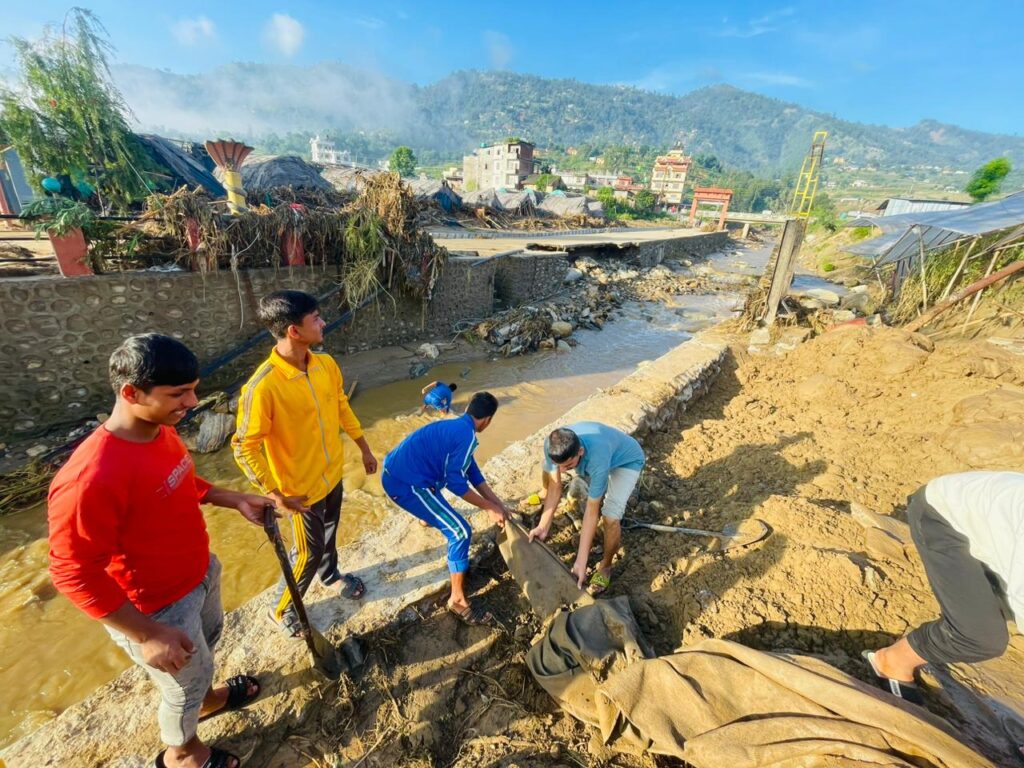

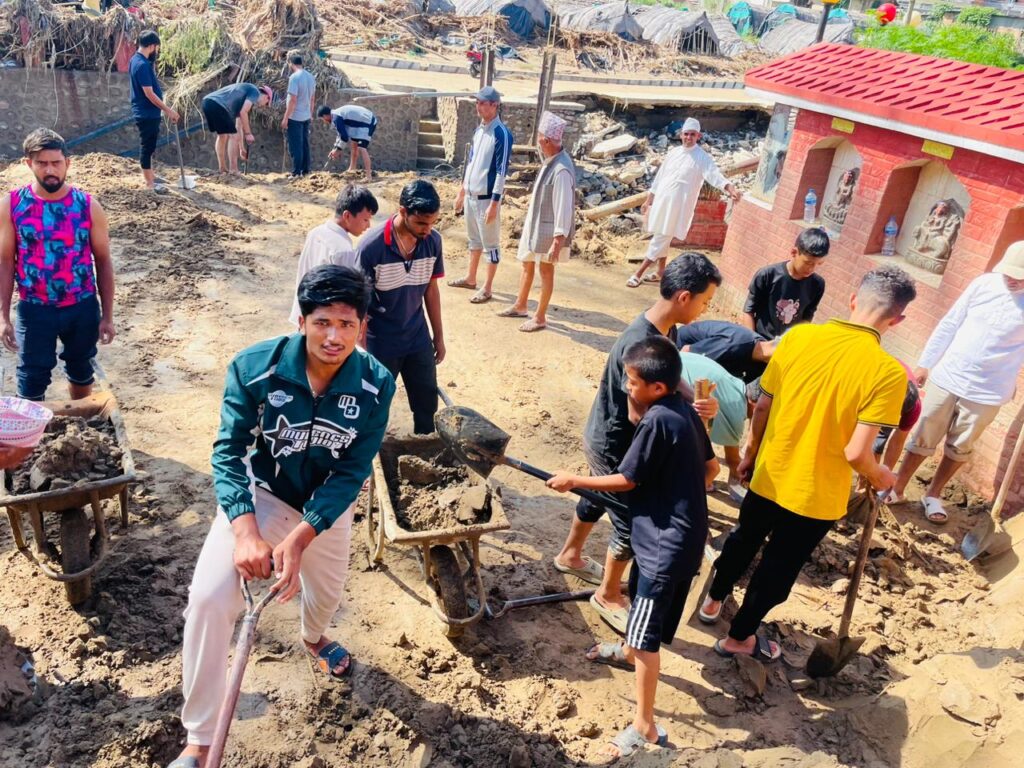
As bad as the damage was in our community, it was quite insignificant compared to what others experienced downriver. Two months after the disaster, I went to a wedding in that area and was saddened to see the totality of the damage. The riverbed had expanded by 200 meters, turning once fertile land into a landscape that looked akin to the surface of the moon. I gaped in awe as I saw a 50 meter gap of road missing above me as I stared up from the very bumpy detour road and then later saw a house horizontal in the middle of the river bed. During the days following the disaster though, people from this area and from farther east, trekked through thigh deep mud with their most valuable possessions to get to Dhulikhil where they could find transit into Kathmandu. Consequently, we had thousands of climate refugees seeking food and shelter in Bhakunde at the end of what had to have been an absolutely grueling day.
It was amazing seeing the community come together like it did. I had heard about the refugee crisis the day after the rains stopped and decided to lend my assistance. That night, I rode my bike into the city center to see almost a thousand people sitting in the street under generator lights being served Dal Bhat from a massive outdoor kitchen. The community leaders seemed to have everything under control there so I continued onto Kutumba Resort where I found hundreds more refugees as well as my counterpart Rakesh, the manager of the resort. He promptly put me to work serving Dal Bhat to the people there. Talking to some of the people, I learned some had walked dozens of kilometers that day. The fatigue and defeat in their faces is something I will never forget.
People slept in every available indoor space there, and soon the resort was at capacity. Around midnight, I rode my bike to the school where the community leaders were directing the last of the people who were in need of shelter. On the way, I helped a very turned-around and fatigued man who had been walking for the better part of 16 hours with a 40-pound bag full of mechanical tools. He had somehow carried it all that way without it ripping off his arm. I guided him to the school and gave his arm some reprieve. The school was a buzz of activity amidst pitch blackness. By this point, everyone’s cell phone had long since run out of battery, and the waning crescent moon only offered the tiniest sliver of light. The stars however, were spectacular. That night, my headlamp seemed to be worth its weight in gold as I lit the way for people to use the restroom and directed them into classrooms quickly filling with exhausted refugees, who fell asleep as soon as their bodies hit the ground.
Five days after the flood, the road to Dhulikhel was finally cleared, and Peace Corps pulled all volunteers out of Kavre. There was still no power, but cell coverage had managed to mostly be back online. A big concern was that the water was no longer potable as the floods had inundated the wells with sediment. We stayed in Kathmandu for 3 weeks as we waited for Peace Corps to declare our sites as safe to return. Three of the eight volunteers in Kavre were reassigned to new districts because of the extent of damage to their site. Two were my good friends.
In the end, 236 people lost their lives including 32 children. 78 people died in my district of Kavre. 4,667 homes were completely destroyed, and an additional 5,310 homes were partially destroyed. 17,000 people were rescued with 910 rescued via helicopter. 88,476 hectares (1 hectare is 10,000 square meters) of paddy fields and 4,765 hectares of fruit and vegetable farms were affected, including my host family’s field. Being next to the river, it got turned into a beach. In a country where few people can afford to insure their homes and land, the financial impact was devastating, especially to those who lost homes which they had recently built and were only beginning to start paying off. The disaster also severely impacted hydropower, potable water projects, health services, and schools. I don’t have an official figure, but my guess is that the cost of the damage is in billions of US dollars, and subsequently, in hundreds of billions of Nepali Rupiya.
As sad as this disaster was, life must move on. Similarly to how the community came together to help the refugees, I was heartened to see my community band together in cleaning up the big mess that the disaster left. The temple complex was buried underneath 4 to 5 feet of soot in some places, and within days (also with a little help from their friendly neighborhood PCV) the complex was free from invading debris. Today, the bridge has been rebuilt, and the walls paralleling the river at the complex have been raised up an additional 4 feet.
When I finally came back to site after a 3-week hiatus, I was pleased to see that the work of farmers had changed the landscape yet again. The rice was being harvested, and in place of the corn, mustard had been planted, turning the rolling landscape vibrant with yellow. Here in South Asia, pretty much everything is cooked in mustard oil which is why in the crop is so heavily produced. My time at site was short lived though, I went back into Kathmandu to meet four friends who had graciously traveled across the world to visit me and the beautiful country of Nepal. My friend Tim who I met in Thailand, Jacob (who is lovingly called Snake), Davis and Jake, the latter three are good friends from IU. We did a short 4-day trek in the Himalayas just outside of Pokhara with four of my Peace Corps friends serving as food security volunteers in Lamjung. When we arrived back in Pokhara, we met up with about 80% of the volunteers serving in Nepal at a hotel I rented out for an informal AllVol (All Volunteers) gathering. The first day fell on Halloween, so naturally, we had a costume contest. Other activities included trivia night (run by yours truly), rafting, tie dying the official AllVol shirts that I had custom printed in Kathmandu, and a volunteer cook out (Mexican food). Those 10 days with my friends and the other volunteers in Pokhara has certainly been a highlight of service.
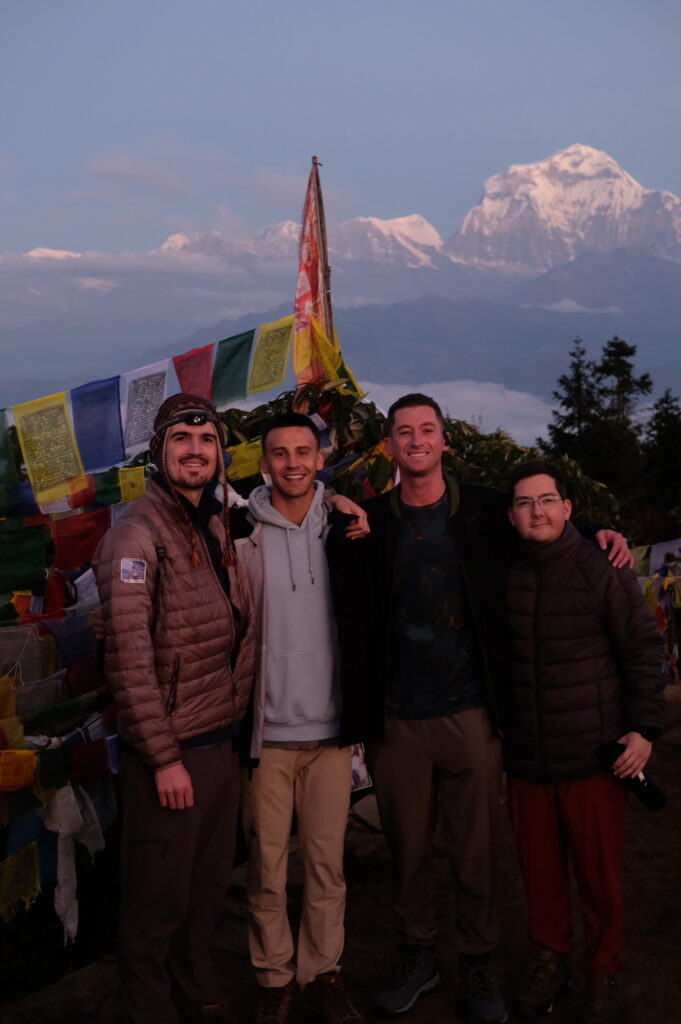
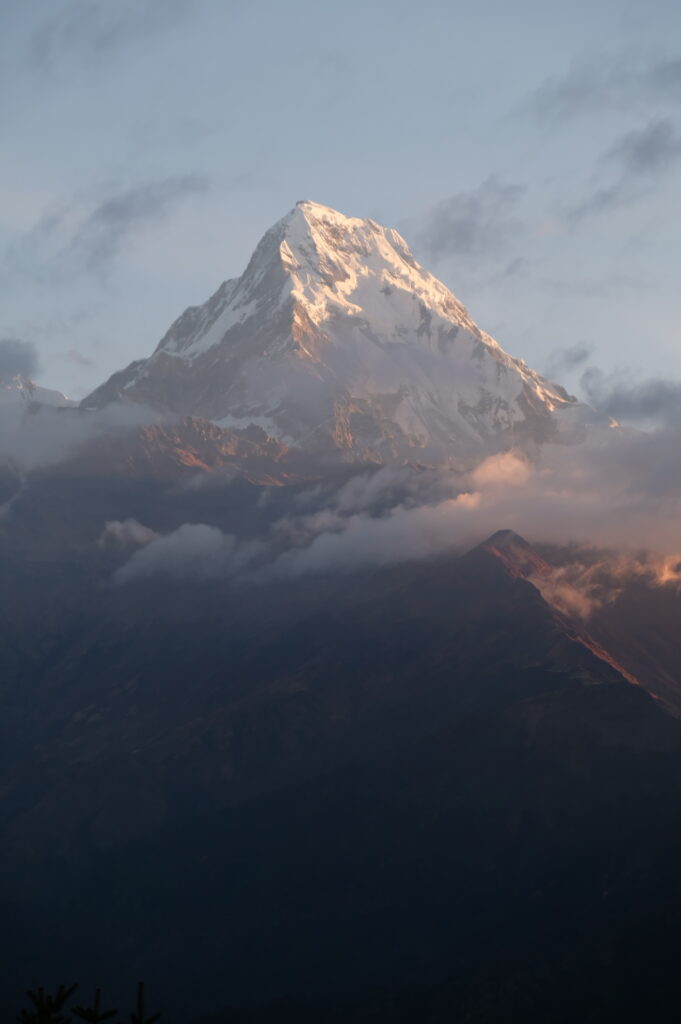
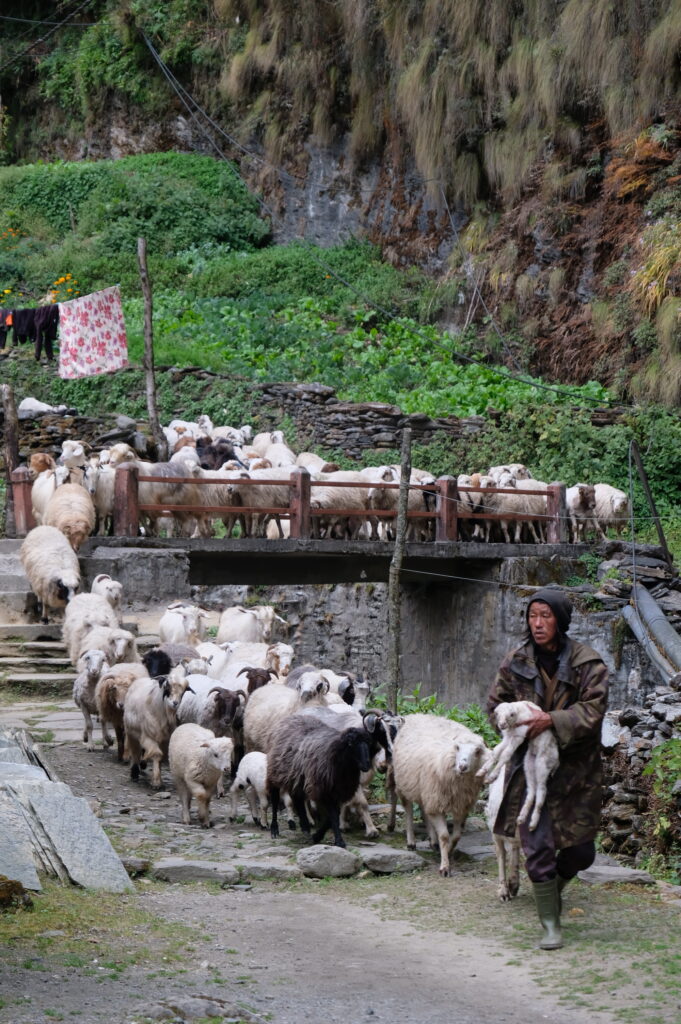
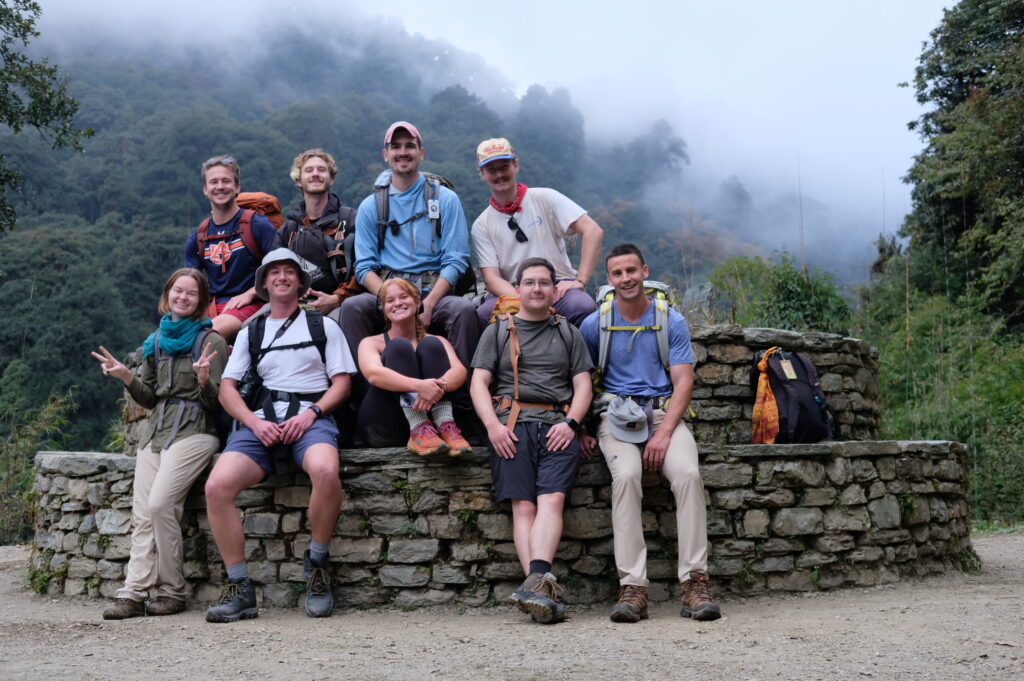
When I returned back to my home in Bhakunde, the village was as beautiful as ever. It was the last day of Tihar, Bhai Tikka, one of the most important Nepali festivals. On this day, sisters give their younger brothers a rainbow tikka. The day is marked with lots of Merigold petals, and of course, lots of food. Since I missed Dashai, the other most important festival of Nepal a month prior due to the Peace Corps evacuation order, it was really important to me that I celebrated Bhai Tikka with my family, and I am glad I did. Even more so now, because not a month after I returned to my village, my Hajur Amaa (Dhai’s mother) passed away.
I have written here before about magnitude of difference between Western and Nepali customs surrounding death, but now living through the mourning process of my host family there is more I would like to share. As you might know from previous blog posts, once someone passes away, it is only hours later that they are cremated at the temple. This is only the first step in a one-year long grieving period. Much the same as in the US, when a loved one is about to die, their children are called to be with them on their deathbed. Same in Nepal, but after the funeral, the sons of the departed shave their heads, and are to stay for 13 days in the same room. They cannot be touched, and they can only eat food cooked by themselves. Food options are limited to rice and ghee. Sometimes fruit is permitted, but nothing prepared with salt is.
The five sons of my Hajur Amaa stayed in the room where she died for two weeks, and in that time, 4000 individuals visited them to offer their condolences and company. I tried to visit after school most days. After the 13 days were completed, the brothers are meant to gather at their mothers house with their family on the 40th day anniversary and also every month following the day she died for 12 months. Additionally, the brothers must shower every day (which can be a real tax when there is no hot water and its 45 degrees Fahrenheit in the morning) can only wear white, and cannot eat meat or excessively spiced or sweetened foods for one year.
On a personal note, it has been strange to see all the people pass in and out of my life this year. My Hajur Amaa was one of the first people I met when I came on my site visit. She was there to celebrate my host sisters birthday. Now she is gone permanently. On a less permanent than death note, PCVs have been dropping out of service like flies. When we first came to Nepal my cohort had 24 members. Today, there are only 13 of us left. Some left for health reasons, some for personal reasons, but almost half of the losses are from people who broke Peace Corps policy. The previous cohort has suffered losses too, and one of them was a good friend who lived just up the mountain from my village. Now that my site mate Jeff has gone back to the US for three months, there are only three volunteers left in Kavre, in comparison to the eight we had just a few months before. This, paired with the fact that my counterpart Rakesh who was best friend at site left to work in London, I would be lying if I said I didn’t feel a little bit isolated. It’s a good thing then that just a few weeks ago, 47 new volunteers arrived in Nepal, more than doubling the number of volunteers in country. Eight of these volunteers will be coming to Kavre, which I am very excited for.
Recently, my Mom came to Nepal to spend one month with me, which was really amazing. We spent 2 weeks in India, and two weeks in Nepal. Here are some of my favorite pictures from the trip.
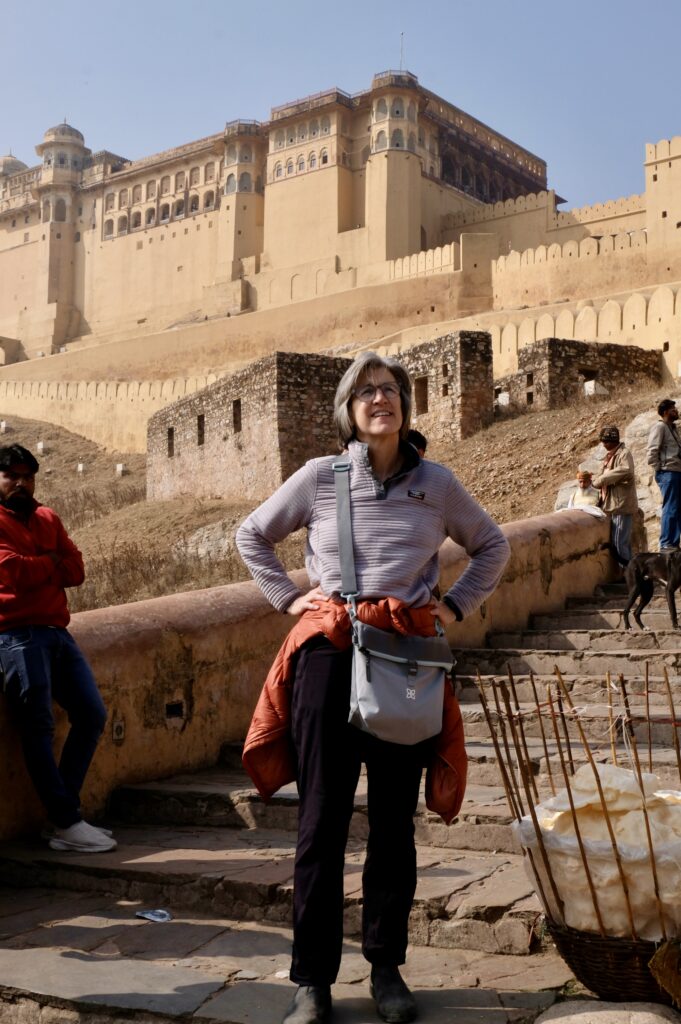
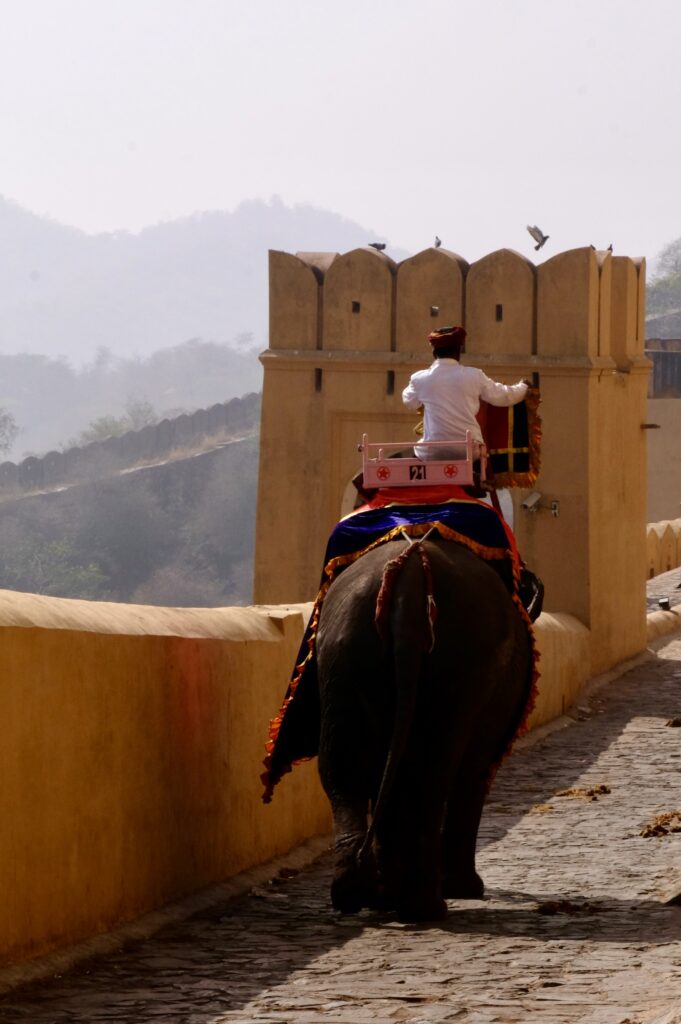
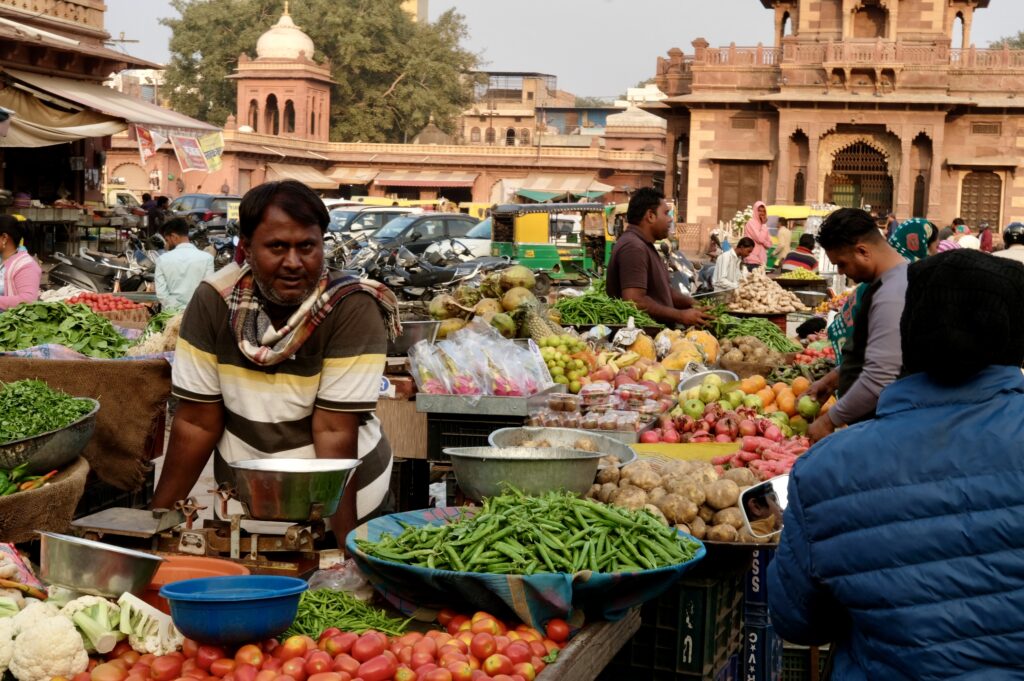
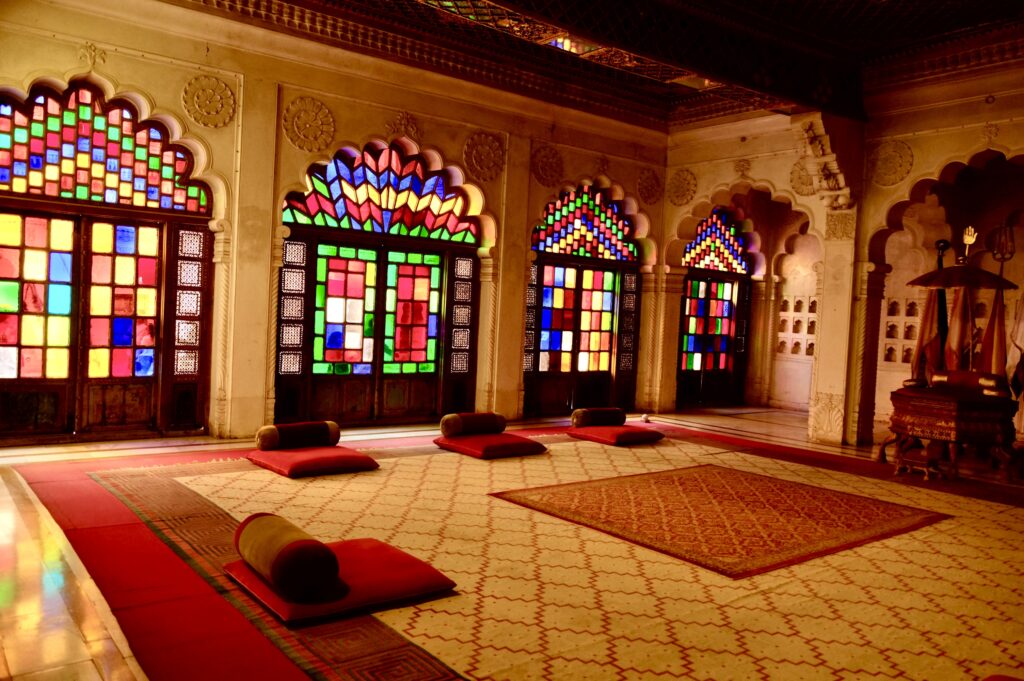
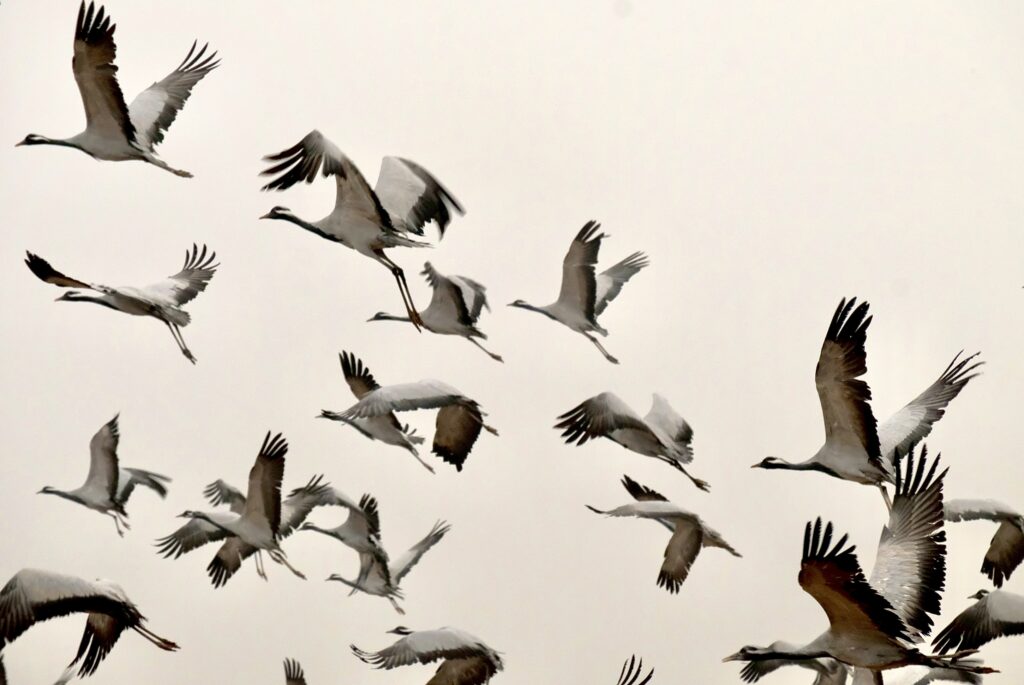
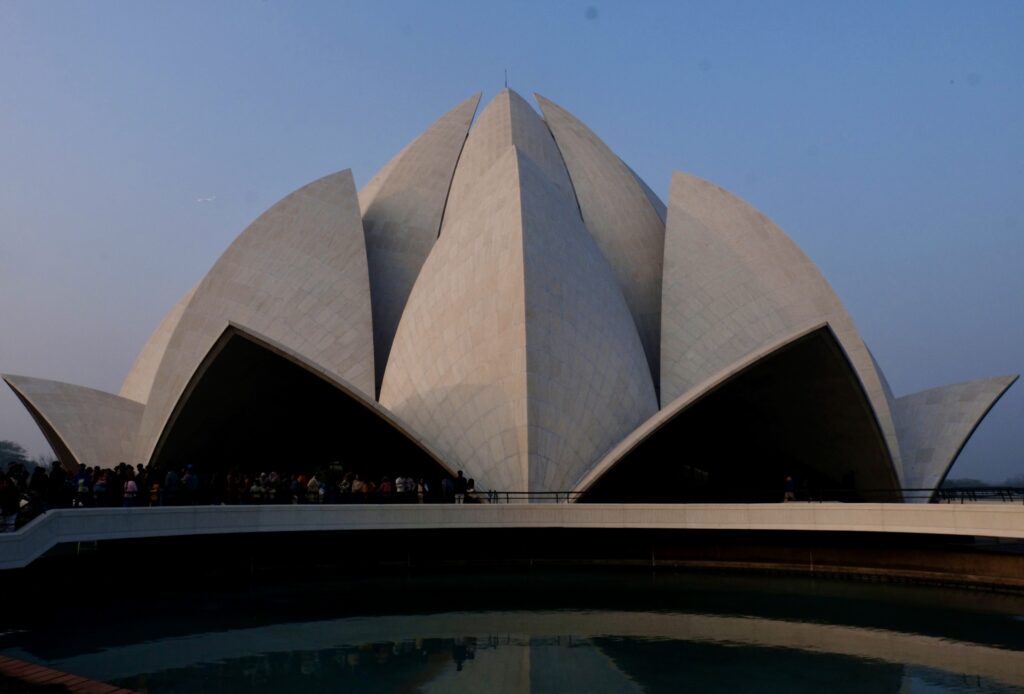
Of course, it would be a mistake not to write about some of my successes at site, but in the interest of brevity I’ll only give a broad overview. This fall, I completed my first grant project (and possibly last now that all foreign aid has been frozen), which was to install headphones with microphone attachments in the computer lab to allow my students to complete speaking exams, and also utilize online English learning resources. I helped to facilitate a virtual exchange program with the students of a PCV serving in the Philippines and organized a PenPal program with my old high school. I have been working to introduce scantron-style tests into the assessment toolboxes for teachers, and my mom and I were able to kickstart an Eco-brick project, which is combating the very serious issue of plastic pollution here in Nepal. Each of these initiatives deserves their time in the spotlight here, but I think I will save that for the next blog post.
Being here a year, I can say with a certain amount of confidence that there aren’t many more cultural curveballs that might surprise me. Barring something drastic from the current executive branch (impacts of halted foreign aid have already been felt here at Peace Corps Nepal), I am very excited for another 14 months in this beautiful country. Nepal still has so much to give me, and there is still a lot more I want to give back. Beyond some of the really special moments I’ve shared with my host family, students, and colleagues that have made my time here feel symbiotic, a highlight of service is when I am walking somewhere and all of a sudden, I am looking up at Langtang Lirung, Gorji Lakpa, Jungal, or Shishpangma, bathed in a beautiful alpine glow. You can’t help but feel humbled and awed at their immensity when staring up at them. The Himalayas are why I came to Nepal, and they continue to remind me that this is where I am meant to be. I am trying to learn all their names and heights so I may greet them as friends all the subsequent times I return to Nepal. My friends though I fear, are losing their glaciers. My counterparts say that a decade ago, the entire range was covered with glaciers. Today, only the tallest peaks are glaciated. I wonder if when I return in 10 years there will be any glaciers left at all. The thought saddens me.
It has been unseasonably warm this winter. Nice for me, bad for glaciers, with highs of 75 and lows of 45. The sky is clear, and the Himalayas are almost always visible these days which is such a treat. Kids are back to playing soccer and cricket everyday afterschool now that the days are getting longer. Farmers are planting potatoes and there’s about 6 different construction projects going on right now. In the midst of all this, I finish writing my blog post. 14 more months, I am saying to myself. Another spring, another summer, another monsoon, and another winter. There seems to be an abundance of all the things I love about this country on the horizon, not to mention plenty more of the challenging bits. Whatever comes, I am ready.

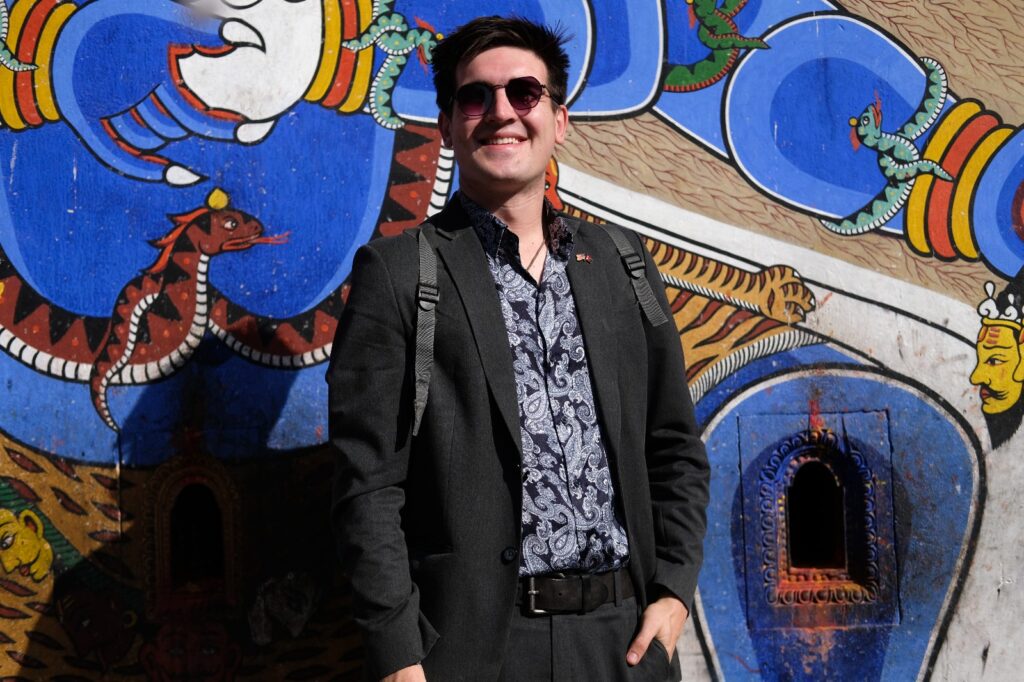
Steve,
I’m touched by your commitment to serve, and the eloquent and respectful way you speak about your experiences. Stay well and safe.
Love,
-Cousin Franny
Steve, I always enjoy reading your blogs, but now that I have been there in person and have seen so many of the places and people you reference, I am enjoying your writing even more!
Thank you for sharing your incredible life with all of us. I’m so proud of you…. And Dad would be over the moon!!
Love, Mom.
Incredible writing by an incredible young man. Thanks for sharing your experiences to date and I am happy for your time in Nepal. So sorry to hear about the recent trials, but thanks for shedding light to them.
God bless,
Trav